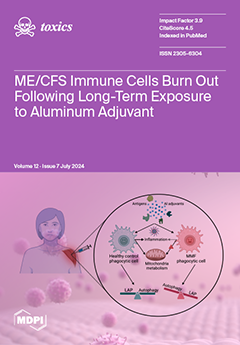Microcystin-LR (MCLR) poses a significant threat to aquatic ecosystems and public health. This study investigated the protective effects of the probiotic
Lactobacillus rhamnosus against MCLR-induced developmental toxicity in zebrafish larvae. Zebrafish larvae were exposed to various concentrations of MCLR (0, 0.9, 1.8, and
[...] Read more.
Microcystin-LR (MCLR) poses a significant threat to aquatic ecosystems and public health. This study investigated the protective effects of the probiotic
Lactobacillus rhamnosus against MCLR-induced developmental toxicity in zebrafish larvae. Zebrafish larvae were exposed to various concentrations of MCLR (0, 0.9, 1.8, and 3.6 mg/L) with or without
L. rhamnosus from 72 to 168 h post-fertilization (hpf). Probiotic supplementation significantly improved survival, hatching, and growth rates and reduced malformation rates in MCLR-exposed larvae.
L. rhamnosus alleviated MCLR-induced oxidative stress by reducing reactive oxygen species (ROS) levels and enhancing glutathione (GSH) content and catalase (CAT) activity. Probiotics also mitigated MCLR-induced lipid metabolism disorders by regulating key metabolites (triglycerides, cholesterol, bile acids, and free fatty acids) and gene expression (
ppara,
pparb,
srebp1, and
nr1h4). Moreover, 16S rRNA sequencing revealed that
L. rhamnosus modulated the gut microbiome structure and diversity in MCLR-exposed larvae, promoting beneficial genera like
Shewanella and
Enterobacter and inhibiting potential pathogens like
Vibrio. Significant correlations were found between gut microbiota composition and host antioxidant and lipid metabolism parameters. These findings suggest that
L. rhamnosus exerts protective effects against MCLR toxicity in zebrafish larvae by alleviating oxidative stress, regulating lipid metabolism, and modulating the gut microbiome, providing insights into probiotic-based strategies for mitigating MCLR toxicity in aquatic organisms.
Full article






